การพัฒนาเทคนิคการทอผ้าและการ แปรรูปที่เหมาะสมของผลิตภัณฑ์ ผ้าคราม ในกลุ่มจังหวัดสนุก
Abstract
บทคัดย่อ
การวิจัยเรื่องการพัฒนาเทคนิคการทอผ้าและการแปรรูปที่เหมาะสมของผลิตภัณฑ์ผ้าครามในกลุ่ม จังหวัดสนุก เป็นการวิจัยเชิงพัฒนา มีวัตถุประสงค์เพื่อ 1) พัฒนาเทคนิคการทอผ้าและแปรรูปผลิตภัณฑ์ผ้าคราม ในกลุ่มจังหวัดสนุก 2) ถ่ายทอดเทคนิคการทอผ้าและแปรรูปผลิตภัณฑ์ผ้าครามในกลุ่มจังหวัดสนุก
กลุ่มตัวอย่างเลือกจากความเข้มแข็งของกลุ่มทอผ้าย้อมคราม เลือกสมาชิกต้นแบบด้วยการสนทนากลุ่ม และคัดเฉพาะผู้ที่มีพื้นฐานและสนใจในการเรียนรู้ กิจกรรมวิจัยแบ่งเป็น 3 กิจกรรม ได้แก่ กิจกรรมที่ 1 พัฒนารูปแบบ ผ้าด้วยการเลือกสมาชิกให้เรียนสร้างลายในเนื้อผ้าด้วยวิธีเก็บตะกอและทอเป็นผืนผ้า กิจกรรมที่ 2 สร้างลายหมี่ จากประสบการณ์ ธรรมชาติและจินตนาการด้วยวิธีบรรยายหลักการและวาดลายบนกระดาษกราฟแล้วมัดหมี่ตาม ลายนั้น ย้อม และทอลายขัดเป็นผืนผ้า กิจกรรมที่ 3 การแปรรูปผ้าย้อมครามเป็นชิ้นงานตัวอย่างก่อนจัดอบรม ปฏิบัติการให้สมาชิกสร้างชิ้นงานเลียนแบบ ประเมินผลทุกกิจกรรมโดยการนำชิ้นงานแสดงนิทรรศการ เก็บข้อมูล จากจำนวนผู้สนใจซักถามและสั่งซื้อ และตรวจสอบยอดขาย
ผลการดำเนินกิจกรรมที่ 1 ได้ฟืมขนาดหน้ากว้าง 30 เซนติเมตร และ 100 เซนติเมตร จำนวน 4 คู่แต่ละ คู่ให้ลายเดียวกัน ทอผ้าย้อมครามได้ 6 ชิ้น จากฟืม 4 ตะกอ 2 เอื้อ 3 ชิ้น ฟืม 5 ตะกอเอื้อเดียว 1 ชิ้น ฟืม 6 ตะกอ ขิดลูกโซ่ อีก 2 ชิ้น พบว่า ผ้าพันคอ หน้ากว้าง 30 เซนติเมตร จากฟืม 5 ตะกอเอื้อเดียว ได้รับความสนใจ มากที่สุด ได้รับการสั่งซื้อทันทีและต่อเนื่อง กิจกรรมที่ 2 ได้ลายบนกระดาษ 34 ลาย ได้รับเลือกมัดหมี่ ทอเป็น ผืนผ้าตัวอย่าง 4 ลาย ได้แก่ ลายปลา ลายผึ้งน้อย ลายกะปอมและลายรอยรถเหยียบขี้ควาย ได้รับความชื่นชมใน ลักษณะผ้าตกแต่ง กิจกรรมที่ 3 ได้ผลิตภัณฑ์แปรรูปต้นแบบ 20 ชิ้น จากผ้าย้อมครามสีอ่อน – แก่ แต่ใช้อบรม ปฏิบัติการเพียง 2 ชิ้น ได้แก่ ซองใส่กระดาษทิชชู และซองใส่กล่องกระดาษทิชชู ได้รับการสั่งซื้อทันที 1 ชิ้น ฟืม 8 ตัว ลายหมี่บนกระดาษ 34 ลาย และผลิตภัณฑ์แปรรูปต้นแบบ 20 ชิ้น เป็นสมบัติของกลุ่มทอผ้า ย้อมครามที่เป็นกลุ่มเป้าหมาย ซึ่งสมาชิกสามารถใช้เป็นต้นแบบนำไปผลิตผ้าย้อมครามได้ต่อเนื่อง แลกเปลี่ยน และ ถ่ายทอดความรู้ให้เพื่อนสมาชิกในกลุ่มและเครือข่ายต่อไป
Abstract
This development research study aimed at : 1) developing weaving and processing techniques , and 2) disseminating weaving and processing techniques in the “Sanook” group of provinces. The sample was a group of indigo fabric weavers with the most strength. The model people were selected through group conversation using their basic knowledge and interest in learning as the criteria for selection. The research comprised three activities. Activity 1 was to select members and have them design fabric patterns by keeping heddles and weaving accordingly. Activity 2 was to have member design weft ikat (mudmee) patterns from experience, nature and imagination following described principles, draw them on graph paper, fasten threads to make weft ikat according to the designed patterns, dye and then weave with fastening threads into fabric. Activity 3 was to turn indigo fabric into model pieces of work, train the members in a workshop where they learned to weave from the model patterns. All the products were assessed through exhibitions where data in relation to the number of people who were interested in the products, inquiries and purchase orders, and sales were collected.
Activity 1 resulted in the obtaining of 4 pairs of two battens with the width of 30 centimeters and 100 centimeters respectively; each pair yielded the same pattern. Six pieces of indigo-dyed fabric were finished as follows: 3 pieces from the batten of 4 heddles with 2-time repetitions in the reverse pattern; 1 piece from the batten of 5 heddles with a 1-time pattern; and 2 pieces from the batten of 6 heddles of a chain pattern. Scarves with the width of 30 centimeters from 5 heddles with a 1-time pattern were most attractive, and were ordered continuously.
Activity 2 resulted in the obtaining of 34 patterns on paper. The weft ikat fabric was selected to be woven into the examples of 4 patterns, namely the fish pattern, the little bee pattern, the chameleon pattern, and the pattern showing a vehicle track on buffalo manure. All were admired as pieces of cloth for decoration.
Activity 3 resulted in the obtaining of 20 model products from the process of dyeing with light or heavy indigo. Two pieces of products were finished from the workshop: a tissues paper pack and a pack for placing a box of tissue paper. One piece was ordered to produce right away.
Eight pieces of battens, 34 patterns of weft ikat fabric on paper and 20 pieces of model products obtained from the whole process of study became the properties of the participating group of weavers, which can be further used as models for producing.









